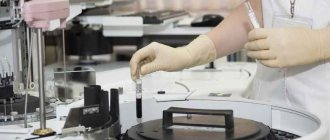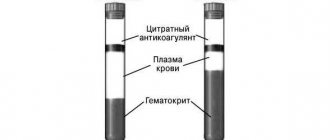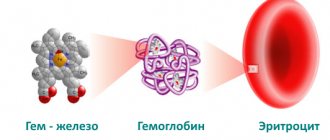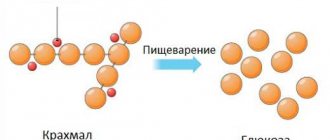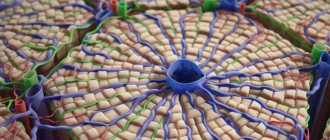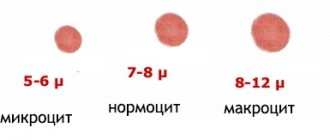Increased hemoglobin is a fairly common phenomenon in men of different ages.
A more common and well-known problem is low hemoglobin, which leads to anemia; increased hemoglobin is no less dangerous; it is probably to some extent more dangerous than low hemoglobin, in that the phenomenon can lead to the development of myocardial infarction and stroke in humans.
Not everyone knows about the consequences of the process of hemoglobin disturbance in the body; such a condition can signal the occurrence of pathological processes in the body.
Often a man does not know about these processes until he takes a blood test.
Hemoglobin should not be allowed to exceed 180 g/l ; if this happens, the reason that caused such a rise must be immediately found out and treated.
Subsequently, an increased level of hemoglobin in the blood may be a reason to contact a specialist due to irreversible processes in the body.
Norm
The norm in this situation is considered to be 120-140 g/l. Numbers may vary, it all depends on the physical and mental state. A long decrease or increase in comparison with normal data indicates problems in the body.
In women, an increased rate is rarely observed. It is possible for hemoglobin to increase by 10-20 units; if the values are even higher, then you definitely need to go to the doctor and get tested. The reasons may be different: blood disease, congenital heart pathologies, oncology, cardiopulmonary pathology. This plasma substance is present in red blood cells, which are produced by the bone marrow. These scarlet bloody cells transport air to various organs. Therefore, with an increase in hemoglobin, there is probably an air deficiency in some area of the body. Because of it, the bone marrow forms a lot of red blood cells, and plasma coagulability increases.
| Floor | Age | Hemoglobin norm, g/l |
| Children | 0 – 14 days | 135-200 |
| Up to 1 month | 100-170 | |
| 1-2 months | 95-130 | |
| 2-4 months | 100-140 | |
| 4-6 months | 110-140 | |
| 6-9 months | 100-150 | |
| 9-12 months | 115-145 | |
| 1-5 years | 110-150 | |
| 5-10 years | 115-145 | |
| 10-12 years | 120-160 | |
| Man | 12-15 years | 120-160 |
| 15-18 years old | 120-170 | |
| 18-45 years old | 130-170 | |
| 45-60 years | 140-175 | |
| Over 60 years old | 120-175 | |
| Woman | 12-15 years | 110-150 |
| 15-18 years old | 120-155 | |
| 18-45 years old | 115-160 | |
| 45-60 years | 120-160 | |
| Over 60 years old | 110-170 |
What is increased hemoglobin and why is it dangerous?
Let's take a closer look at the causes of high hemoglobin and the treatment of this abnormality before it leads to serious health problems.
Hemoglobin is a protein that transports oxygen and carbon dioxide along the lung-cell route. The normal concentration for men is 140 g/l, and for women - 130 g/l. Doctors also note that each age category has individual indicators.
A change in the concentration of this protein by 20 units is considered a deviation from the norm. When hemoglobin decreases, doctors talk about the development of oxygen starvation (hypoxia), which can provoke premature tissue death. If the amount of protein increases excessively, then the number of red blood cells also increases.
And this, in turn, leads to blood thickening, which can cause serious disorders:
- thrombosis;
- stroke;
- heart attack;
- pulmonary thromboembolism.
Such consequences arise only due to the high concentration of hemoglobin and red blood cells. But the violation can be secondary, i.e. the result of any illness. And therein lies an even greater danger!
Causes of high hemoglobin
Increased level of hemoglobin in the blood in women, what is it? If this indicator changes, it means that there is a problem with a specific organ and system. Although sometimes high hemoglobin is the norm - for example, in people who live in the mountains or in elevated areas. The main reasons why high hemoglobin occurs in women are as follows:
- Hemoglobin often increases in those who smoke, as well as in those who have recently been in a fire. The fact is that hemoglobin easily transports air or carbon dioxide, replacing them with each other.
- A high level of water deficiency raises blood counts, resulting in an increase in the amount of circulating plasma.
- Congenital heart disease caused by high pressure in the pulmonary artery blood flow. In this situation, the skin color changes from infancy and has a blue tint. The child coughs frequently and has shortness of breath. Ultrasound of the heart allows you to determine an accurate diagnosis. Treatment of such pathologies with severe symptoms is only surgical.
- Pulmonary diseases.
- Excessive amounts of vitamins B6 and B12 in the human body.
- Cancerous neoplasms.
However, a high level of hemoglobin in the blood can not only indicate various diseases, but also signal that you lead a different lifestyle and live in an unfavorable place.
increased hemoglobin in women
Causes of increased hemoglobin levels
Hemoglobin levels can be influenced by a variety of functional and pathological factors. Their list includes:
- a long period of stay of people in high mountain areas, among the characteristic features of which are low atmospheric pressure, insufficient amount of oxygen from rarefied air for the normal functioning of the respiratory system
- passion for mountaineering
- living in industrial urban areas characterized by increased smoke and gas contamination of the surrounding environment with harmful substances
- high physical activity that causes tension in the male body due to performance of work duties, amateur or professional sports
- dehydration caused by irreplaceable loss of fluid due to work in hot climates, lack of opportunity to organize proper drinking regime
- disruption of the absorption of B vitamins
- addiction to alcohol and smoking, which impairs the supply of oxygen to tissues
- diagnosing oncology, endocrine diseases, intestinal obstruction, pathologies of the cardiac and vascular system
- manifestation of side effects after the use of medications, anabolic agents
Such reasons are prerequisites for determining hemoglobin levels. Timely adoption of measures to reduce it provides an opportunity to avoid the development of serious complications such as thrombosis of blood vessels, myocardial infarction, stroke and other diseases that pose a threat to the lives of patients.
Signs and consequences of increased hemoglobin
With a high level of hemoglobin in the blood, women may have no symptoms at all, but with a long and high value along with other diseases, the patient may have vague symptoms:
- constant fatigue
- desire to sleep,
- lethargy,
- loss of appetite,
- sleep problems,
- aches in joints and bones,
- high blood pressure,
- itching of the skin, particularly after showering and bathing,
- stomach ache,
- instant bruising and easy bruising.
All these symptoms disappear externally. But the most serious of them take place inside the body. There is an increase in the coagulability of the blood space, an increase in its concentration and a reduction in the speed of movement in the body. Because of this, the internal organs do not receive proper nutrition. If this condition is neglected, blood clots and plaques can form, which cause heart attacks and strokes.
Red blood cells are normal
The normal limits vary depending on gender, age and other characteristics.
So, for an adult man it ranges from 4.0 to 5.1 × 10¹² units per liter of blood, and for women - 3.7 to 4.7 × 10¹² per liter.
In pregnant women, red blood cells may decrease to 3–3.5 x 10¹² per liter.
In children under one year of age, the concentration of red blood cells is constantly changing, so to assess the composition of their blood there is a special table that doctors use when interpreting tests.
In childhood, after one year there are still slight deviations from the “adult” norm, but by adolescence the level of red blood cells levels out.
How to reduce hemoglobin in the blood?
If what causes hemoglobin to rise has nothing to do with serious illnesses, then you can influence it with a specific diet or medications. Among the pharmaceutical medications that can be easily purchased at the pharmacy, there are those that are aimed at thinning the blood: Trental, Cardiomagnyl, Curantil, Aspirin. Only a doctor should prescribe them! To reduce hemoglobin at home, you need to adjust your diet:
- Drink plenty of fluids per day. To do this you need to drink warm water. If you cannot do this, then saline drips are used.
- Reduce fats, sweets, eggs, as they increase cholesterol and so in a viscous environment.
- You should not take multivitamins or products that contain copper and iron.
- It is better to choose shrimp, fish, white meat, nuts, legumes, and vegetables.
- Also limit your intake of foods that increase hemoglobin. This is food enriched with protein and iron - red meat, red fruits and vegetables, offal, fish roe, butter, buckwheat, sweets.
Now you know why increased hemoglobin appears in a woman .
Diagnostic procedures for elevated hemoglobin
As with any other disease, early diagnosis is important for elevated hemoglobin.
The sooner you can find out the cause of this pathological deviation, whether it is an independent symptom or a manifestation of a more serious disease.
Diagnosis consists of a general blood test.
If the doctor doesn’t like the tests, he will send you for additional examinations.
After the diagnosis is made, the doctor prescribes a plan of treatment procedures, medication, and proper nutrition.
Tests for red blood cells
A red blood cell count and cell count is usually done as part of a complete blood count (CBC).
A general blood test is the most common analysis, informative for almost any pathological process. This test can also be used to diagnose and/or monitor a number of diseases that affect the production or lifespan of red blood cells. You can take a general blood test with determination of 5 fractions of leukocytes at any CityLab medical center.
For an accurate diagnosis, the doctor may prescribe additional tests:
- Reticulocyte count - determines the number of immature red blood cells.
- Iron test - this trace element plays an important role in the production of red blood cells.
- Vitamin B12 and folic acid levels – these vitamins are also important for red blood cell production.
- A blood test for ferritin reflects iron reserves in the body.
- Serum iron, total iron-binding capacity of blood serum are additional parameters reflecting the process of iron metabolism in the body.
Decreased red blood cells
The main symptoms of low red blood cell count are:
- Weakness or fatigue.
- Lack of energy.
- Paleness of the skin.
Reduced red blood cells are a relatively common pathology.
A low number of red blood cells and/or hemoglobin is called anemia. If there are few red blood cells, there is correspondingly less hemoglobin in the bloodstream, which carries oxygen. Thus, the body experiences oxygen starvation, and we feel weakness, drowsiness, loss of vitality, and dizziness. Due to anemia, hair falls out, the skin becomes pale and dry. There are many forms of anemia, each with its own cause. Anemia can be temporary or acquired; depending on severity - from mild to severe. According to a 2015 publication in The Lancet, about one-third of the world's population is anemic.
The most common causes of low red blood cells are:
- Unbalanced diet with deficiency of iron, vitamin B12 or folic acid.
- Damage to the bone marrow (toxins, radiation or chemotherapy, infection, certain medications).
- Any bone marrow disease.
- Chronic inflammatory processes.
- Bleeding in the digestive tract (for example, from ulcers, polyps, colon cancer).
- Heavy menstrual bleeding.
- Trauma with massive blood loss.
- Conditions that cause the destruction of red blood cells (for example, hemolytic anemia caused by autoimmune processes or defects in the red blood cells themselves).
- Kidney failure – serious kidney pathologies lead to a decrease in erythropoietin (or hematopoietin), a kidney hormone that promotes the production of red blood cells.
The risk of anemia is higher in the following groups:
- children aged from 6 months to 2 years;
- pregnant or recently given birth women;
- following a diet low in vitamins, minerals and iron, red meat;
- patients who regularly take medications that cause inflammation of the gastric mucosa (for example, ibuprofen);
- having a family history of hereditary anemia such as sickle cell anemia or thalassemia;
- patients with an intestinal disorder that affects the absorption of nutrients (eg, Crohn's disease);
- have recently experienced major blood loss due to surgery or injury;
- people with chronic diseases (HIV, diabetes, kidney disease, cancer, rheumatoid arthritis, heart failure, liver disease).
What is hemoglobin
Hemoglobin is a complex protein containing iron. Its main task is to add oxygen diffusing into the blood from the lungs and distribute it throughout the body. Giving oxygen to cells, hemoglobin attaches carbon dioxide formed by them in the process of vital activity. Then getting through the bloodstream to the lungs, it gives it away, again making room for oxygen. This is how gas exchange and tissue respiration occur. But, in addition, hemoglobin is involved in maintaining the acid-base balance, in DNA synthesis, and in the occurrence of a number of redox reactions.
To synthesize hemoglobin, the body uses iron, which comes from food and accumulates in the form of ferritin in the liver, lungs, and spleen. There is also a small amount of iron present in the intestinal mucosa. If the diet does not meet the body's iron needs, ferritin is activated. This helps maintain normal hemoglobin levels and organ function. But with prolonged deficiency, its reserves are depleted, and the concentration of hemoglobin decreases.
In men, critically low hemoglobin levels are rare, since they, unlike women, do not experience regular physiological bleeding. For the same reason, the increase in hemoglobin in men occurs faster and more effectively. But if left untreated, there is a serious risk of complications, especially if you have bad habits:
- thrombosis;
- myocardial infarction;
- stroke;
- decreased immunity;
- deterioration of cognitive functions (memory, attention);
- hypoxic coma.
Often, when low hemoglobin persists for a long time, the presence of chronic fatigue syndrome is observed.
Products that increase hemoglobin: not just meat!
Low hemoglobin levels can occur in people whose diet is unbalanced. How can you increase your hemoglobin level?
The daily requirement of an adult for iron is approximately 12 mg. The use of certain dietary supplements in addition to a balanced diet can become one of the sources of microelements for the body. Read more…
Taking dietary supplements in addition to a balanced diet can help avoid iron deficiency and decreased hemoglobin levels in the blood. Why is low hemoglobin level in the blood dangerous?
Chronic iron deficiency can lead to a decrease in hemoglobin, a protein that carries oxygen, in the blood and provoke the development of anemia. Measures to prevent iron deficiency anemia...
Lack of iron in the body can cause the development of iron deficiency anemia. How can you restore normal hemoglobin levels in the blood?
"Ferrohematogen" can be recommended as a dietary supplement to food as an additional source of iron, vitamins C, B6, B9 and copper. Find out the cost...
Dietary supplement Not a medicine.
Hemoglobin is the basis of red blood cells, the most important elements of blood. Few people think that our well-being, activity and even appearance depend on the level of its content in the blood. In order to maintain normal hemoglobin levels, you need to provide the body with sufficient iron. You can replenish iron deficiency naturally, without pills. But you need to know the list of products that increase hemoglobin and be able to combine them with each other.
Daily intake of iron to maintain physiological levels of hemoglobin in the blood
Blood carries and delivers oxygen to all cells of our body thanks to hemoglobin. It contains the bulk of all iron found in the human body. For example, a woman weighing 50 kg with normal hemoglobin contains 1.1 g of iron in her blood. Hemoglobin level is determined along with other indicators during a general blood test. A normal concentration is considered to be 130 g/l for men and 120 g/l for women.
For children, the hemoglobin norm depends on age:
- up to 2 weeks - 125–225 g/l;
- per month - approximately 100–180 g/l;
- from 2 to 6 months - 90–140 g/l;
- from 6 months to 2 years - 106–148 g/l;
- from 3 to 6 years - 103–143 g/l;
- from 7 to 12 years -111–146 g/l;
- from 13 to 16 years old - 112–153 g/l in girls and 118–164 g/l in boys;
- at 17–19 years old - 112–147 g/l in girls and 120–167 g/l in boys.
Iron requirements depend on a person's age, gender, weight, level of physical activity, and concomitant conditions such as pregnancy or recent blood loss.
A newborn has its own supply of iron, which is gradually used up. Therefore, the need for it at this time is small - only 0.27 mg. Gradually, the depot is depleted and for full development the child needs to receive about 11 mg of this microelement per day from food.
Until approximately 13 years of age, a child should receive 7 to 10 mg of iron. But with the onset of puberty, the situation begins to change dramatically. From now on, the required amount of iron for boys and girls will be different.
It is enough for teenage boys to get about 11 mg of this trace element per day. This amount is quite enough for their growing body. Girls at the same age need to receive up to 15 mg of iron. After all, they not only experience active growth and development of all internal organs, but also the formation of the reproductive system, and regular blood loss begins during menstruation.
After 19 years, men's need for iron decreases to 8 mg per day, while in women, on the contrary, it increases to 18 mg, and during pregnancy - to 27 mg per day. This is due to the physiological characteristics of the female and male body.
What causes hemoglobin to decrease and why is it dangerous?
The level of hemoglobin directly depends on the amount of iron in the body. The greater the consumption of iron and the less it comes from food, the higher the likelihood of developing anemia.
If the amount of hemoglobin decreases, the blood begins to carry less oxygen. The tissues are starved of oxygen, which can cause dizziness, frequent heavy breathing, fainting, or heart pain.
During pregnancy, hemoglobin levels are especially important. Anemia that occurs during this period increases the risk of toxicosis, gestosis, premature birth and miscarriage. When hemoglobin drops below normal, immune disorders, placental insufficiency occur, and fetal development is disrupted.
Figures and facts During pregnancy, about 1300 mg of iron is consumed.
During the period of growth, children's need for iron sharply increases, and if there is a lack of iron-containing foods in the diet, their hemoglobin may decrease. This leads to rapid fatigue, developmental disorders, and decreased academic performance. Therefore, if such signs appear, it is advisable to get tested.
Vegetarians are considered another risk group. Iron is not absorbed from plant foods as well as from animals, and getting your “norm” is quite difficult. In addition, many plant products containing large amounts of iron also contain substances that interfere with its absorption.
In older people, the decrease in hemoglobin levels does not manifest itself as in middle age. Instead of brittle nails, hair loss or dry skin, symptoms of iron deficiency such as shortness of breath, weakness and dizziness come to the fore. These symptoms are often attributed to age or heart disease. At the same time, changing your diet, taking dietary supplements or medications help correct hemoglobin deficiency and significantly improve your condition.
The main reasons that can cause hemoglobin deficiency are:
- increased need for iron, for example, during active growth or pregnancy;
- bleeding, including periodic and hidden;
- unbalanced nutrition or diets.
If in the first two cases you definitely need to consult a doctor about prescribing special medications, then in case of iron deficiency associated with nutrition, it is enough to adjust your diet.
What foods increase hemoglobin?
The production of hemoglobin requires amino acids and iron. It would seem that if you eat foods high in iron, this should solve the problem. But in reality it's not that simple.
The absorption of this microelement strongly depends on the acidity of gastric juice, on the condition of the intestines, on the combination of foods and the presence of certain substances in them. For example, about 15–20% of the iron found there is absorbed from meat, but no more than 1–5% from vegetables. This is why it is possible to raise hemoglobin with foods such as apples or pomegranates, but it will take a lot of time.
Beef “raises” hemoglobin best, chicken and turkey meat are a little less effective. Iron is absorbed worse from eggs and liver.
If you take plant foods that increase hemoglobin, carrots, potatoes, cabbage, broccoli, tomatoes, cauliflower and pumpkin work best. They contain large amounts of citric, malic and ascorbic acid, which help iron enter the body. But it is practically not absorbed from spinach, wheat (including bread) or lentils, since these products contain a large amount of phytins.
It is advisable to limit the intake of tea and coffee. They contain large amounts of tannin, which interferes with the absorption of iron. By drinking a large amount of strong tea, you can completely stop the flow of this microelement into the body.
How to increase the absorption of iron from food
In order for products that increase hemoglobin to be most effective, it is important to combine them correctly. To do this, you need to remember a few rules.
Increases the bioavailability of iron:
- ascorbic acid (rose hips, bell peppers, cauliflower);
- copper (liver, peanuts, buckwheat, cereals);
- folic acid (beef liver, cod liver, walnuts);
- citric and malic acid (citrus fruits, tomatoes, peppers);
- sulfur-containing amino acids (meat, fish, seafood);
- sugar.
Reduce the bioavailability of iron:
- calcium (dairy products);
- phytates (bread, legumes);
- milk and soy proteins;
- tannin (tea, coffee, pomegranate, persimmon);
- phosphates (canned foods, processed cheese, carbonated drinks).
If you know what foods you need to eat to increase hemoglobin, you can simply create a menu for yourself to prevent iron deficiency. It is especially important to take care of proper nutrition for children and pregnant women. And, of course, it is better to think about your health before the first signs of a decrease in hemoglobin appear.
Prevention of hemoglobin deficiency in the blood
Only a doctor can treat low hemoglobin levels, but everyone can prevent this condition.
We asked an expert to give some useful tips. “The most important prevention of anemia is to prevent iron deficiency in the body. A nutritious diet helps avoid this problem. But if iron consumption is increased, it is difficult to prevent deficiency. In this case, dietary supplements and special medical nutrition can come to the rescue.
Dietary supplements contain iron in a form that is easily absorbed. In addition, they often add substances that improve its bioavailability.
When choosing a dietary supplement, pay attention to its composition. It should not contain “extra” components, preservatives, confectionery or other additives. For children, it is better to choose supplements not in tablets, but in the form of syrup or sweet bars. Such as, for example, “Ferrohematogen”.
"Ferrohematogen" is made from natural, safe products without taste improvers. The product contains iron in its natural heme form, and is additionally enriched with vitamin C, B6, folic acid and copper. Thanks to this composition, iron is quickly absorbed and goes into hemoglobin synthesis.
Since Ferrohematogen contains no artificial additives, it can be taken even by children (from 3 years old) and pregnant women.”
PS More information about the product can be found on the website www.ferrogematogen.ru.
